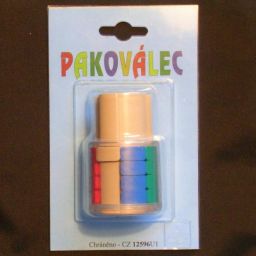


Pakoválec is a recent Czech puzzle, its name roughly translating as 'Stupid Cylinder'. This cleverly designed puzzle consists of a long vertical cylinder inside a shorter transparent tube. Captured between the two are 16 coloured pieces, lying in four vertical columns, held in place by vertical grooves in the inner cylinder. There is also a horizontal groove going around the cylinder, which contains a ring of eight pieces - one piece from each column as well as four more pieces of the same colour as the cylinder. When you rotate the outer tube, the ring of eight pieces are rotated too, and when you shift the outer tube up or down, it is the four columns that are shifted. When solved, the each column has a different colour (red, blue, green, yellow). Note that four columns are not evenly spaced - two are adjacent, right next to an extra wide gap before the next column.
This puzzle is of an extremely simple but effective design. The horizontal groove has a long spring underneath the pieces, wrapped around the cylinder. This spring pushes the eight pieces outwards against the outer tube, so that when the tube is rotated these pieces are dragged along by friction. This same spring is responsible for the clicking action that occurs when the tube is shifted up or down. The pieces have horizontal grooves on their underside, so they nestle onto the spring with a satisfying feel. The only disadvantage of this simple design is that excessive play will cause some scratching of the outer tube.
It was invented by Pavel Gebr, and he filed for a Czech utility patent on 26 July 2002, which was granted in 6 September 2002, CZ 12,596 U.
If your browser supports Javascript, then you can play Pakoválec by clicking the link below:
There are 20 pieces, giving a maximum of 20! positions. This limit is not reached because:
This leaves 20!/(4!6) = 12,730,843,125 positions.
 The solution below assumes you hold the tube with the adjacent columns at the front,
and the other columns to the right and back. The big gap between columns is on the left.
To make it easier to describe, I will number the columns and gaps from left to right,
so the columns get the numbers 2, 3, 5 and 7. The diagram on the right illustrates this.
The four rows are labelled from A at the top to D at the bottom.
The solution below assumes you hold the tube with the adjacent columns at the front,
and the other columns to the right and back. The big gap between columns is on the left.
To make it easier to describe, I will number the columns and gaps from left to right,
so the columns get the numbers 2, 3, 5 and 7. The diagram on the right illustrates this.
The four rows are labelled from A at the top to D at the bottom.
Important: To keep this labelling consistent, never rotate the inner cylinder,
but only move the outer tube.
Phase 1: Solve the top row, row A
Phase 2: Solve rows B and C.
The next two rows can be solved in exactly the same way as row A. You will never have to disturb
the previously solved row(s).
Phase 3: Solve the last row, row D.
Instead of laying out explicit steps for each piece, I will give a few easy
move sequences that make small changes in row D. By applying these sequences
freely you can solve the last row much more easily than any rigidly defined
set of steps.